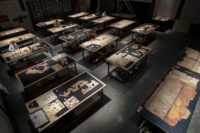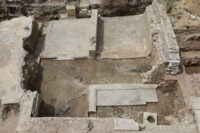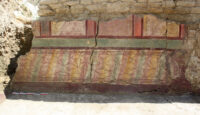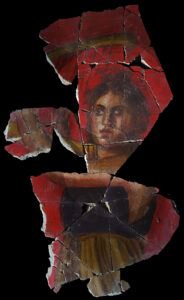 Archaeologists have undertaken a three-year project to piece together thousands of fragments of wall frescoes recovered the House of the Harpist, a uniquely important Roman villa in Arles, southeastern France. This is endeavor of enormous ambition. There are 800 crates of fresco fragments which makes for the most complex jigsaw puzzle imaginable, and conservators will be studying the painting, materials and construction as they work to reassemble as much of them as possible.
Archaeologists have undertaken a three-year project to piece together thousands of fragments of wall frescoes recovered the House of the Harpist, a uniquely important Roman villa in Arles, southeastern France. This is endeavor of enormous ambition. There are 800 crates of fresco fragments which makes for the most complex jigsaw puzzle imaginable, and conservators will be studying the painting, materials and construction as they work to reassemble as much of them as possible.
 Built in 70-50 B.C. by craftsmen from Italy, the House of the Harpist is exceptional in Arles, because it predates the formal founding of the town as a colony for the veterans of Julius Caesar’s legions in 45 B.C. It had been under Roman control since the 2nd century B.C., but the Roman city of which extensive remains still survive today, including the spectacular amphitheater, date to the imperial era. It was a trendsetter for all of Gaul, introducing Roman construction and decorative techniques like opus spicatum (masonry laid in a herringbone pattern) that would not take hold in the province until decades later (ca. 30 B.C.).
Built in 70-50 B.C. by craftsmen from Italy, the House of the Harpist is exceptional in Arles, because it predates the formal founding of the town as a colony for the veterans of Julius Caesar’s legions in 45 B.C. It had been under Roman control since the 2nd century B.C., but the Roman city of which extensive remains still survive today, including the spectacular amphitheater, date to the imperial era. It was a trendsetter for all of Gaul, introducing Roman construction and decorative techniques like opus spicatum (masonry laid in a herringbone pattern) that would not take hold in the province until decades later (ca. 30 B.C.).
 The domus with all its luxurious appointments and fine construction barely lasted two decades. It was destroyed between 50 and 40 B.C. and backfilled with its own rubble. Three villas were subsequently built over it, the last of which was destroyed by fire in 260 A.D. The city of Arles acquired the property in 1978 in order to excavate and preserve the known Roman remains. Excavations have taken place at the site regularly since the acquisition. The House of the Harpist was revealed during digs between 2014 and 2017.
The domus with all its luxurious appointments and fine construction barely lasted two decades. It was destroyed between 50 and 40 B.C. and backfilled with its own rubble. Three villas were subsequently built over it, the last of which was destroyed by fire in 260 A.D. The city of Arles acquired the property in 1978 in order to excavate and preserve the known Roman remains. Excavations have taken place at the site regularly since the acquisition. The House of the Harpist was revealed during digs between 2014 and 2017.
 The frescoes were done in the Second Style, featuring trompe-l’œil architectural motifs like columns and imitation marble panels, setting off figural and landscape elements. There are no more than 15 Roman sites with Second Style frescoed elements in France, and this group is by far the greatest in quantity, quality and completeness. The painting that gives the house its name — a woman playing the harp who is part of a cycle of figures depicted on pedestals that were likely part of a Bacchic procession — is unique in France because of its brilliant vermillion red background in excellent condition. The only comparable red-background pieces are found in Italy, most notably in Pompeii’s Villa of the Mysteries.
The frescoes were done in the Second Style, featuring trompe-l’œil architectural motifs like columns and imitation marble panels, setting off figural and landscape elements. There are no more than 15 Roman sites with Second Style frescoed elements in France, and this group is by far the greatest in quantity, quality and completeness. The painting that gives the house its name — a woman playing the harp who is part of a cycle of figures depicted on pedestals that were likely part of a Bacchic procession — is unique in France because of its brilliant vermillion red background in excellent condition. The only comparable red-background pieces are found in Italy, most notably in Pompeii’s Villa of the Mysteries.
 Starting in April of this year, fragments have been spread out over 2400 square feet in an exhibition room at the Departmental Museum of Ancient Arles for recomposition and study. Toichographologists (archaeologists who specialize in the excavation and study of ancient painted walls) will stabilize the paint so the fragments can be made readily available for study. Researching the vermillion red in the background of the woman with the harp is a particular priority as the pigment is prone to blackening.
Starting in April of this year, fragments have been spread out over 2400 square feet in an exhibition room at the Departmental Museum of Ancient Arles for recomposition and study. Toichographologists (archaeologists who specialize in the excavation and study of ancient painted walls) will stabilize the paint so the fragments can be made readily available for study. Researching the vermillion red in the background of the woman with the harp is a particular priority as the pigment is prone to blackening.
The fragments, some barely bigger than a fingernail, have been washed, labelled and placed into the cases to be examined one by one to see where they might fit into a bigger picture. So far, the specialists have spent a total of 1,800 hours picking through the pieces.
“We estimate it takes us one day per case, so around 1,000 days to study all of them,” Julien Boislève, an expert in ancient wall paintings, said. “It’s exactly like a puzzle … except of course we don’t have the original model to work from or all of the pieces, which means it’s fastidious work. It’s a major task but we are lucky to have a large quantity of good quality pieces of the decor, which is rare.”
Nearby Massalia had been a Greek colony already in the late 7th century BC, as Θηλίνη (“Theline”) –i.e. the old name of Arles– had been a little later.
Allegedly, that name is derived from θηλή (nipple, tit), but so far I would not know why.
—–
Σιγύννας δ᾽ ὦν καλέουσι Δίγυες οἱ ἄνω ὑπὲρ Μασσαλίης οἰκέοντες τοὺς καπήλους./ ‘Sigynnae’ is what the Ligurians who dwell in the region inland above Marseille [in the region of Θηλίνη] call traders. (Herodotus Bk.5.9, ca. 430BC)
—–
Those “Sigynnae” could have been the folks that Greeks and Punian traders sold their stuff to, i.e. in addition to Ligurians sales.
Caesar himself lets us know that Greek letters were in use in what later would become “Gaul”.
I feel so blessed again in my marriage after PRIEST OSAS brought back my husband that separated with me for good 3 months. ANNY ROBERT by name from California. Even though I have mouths all over my body, it won’t be enough to thank PRIEST OSAS for his help in my life. My husband separated with me for 3 months and has been in pain and agony without him. So, I searched for help everywhere but nothing worked out not until I meant PRIEST OSAS who I contacted online. I explained my situation to him and he promised that my husband will get back to me within 24 to 48 hours so that my heart still beats for him. I believed in him and he prepared a spell for me and my husband called me exactly when PRIEST OSAS said. He pleaded and said he needs me back and now we are living happily again for the past 9 months. Everyone out there reading my article that needs help should contact him… Email: Unsurpassed.solution@gmail.com or WhatsApp him : +1(419)359-4367
https://unsurpassedsolution.blogspot.com/
https://unsurpassedsolutionhome.website2.me/
I understand Egyptologists have developed a computer program for putting myriad pieces together digitally. They scan the piece and upload it to database (or something) and have been successful in reconstructing virtually some lost artworks. Seems like I recently read about this being used in the Hypostyle hall at Karnak and maybe (?) at Amarna. It would be great if the two groups of archeologists shared resources. It could potentially speed up the Harpists reconstructions.